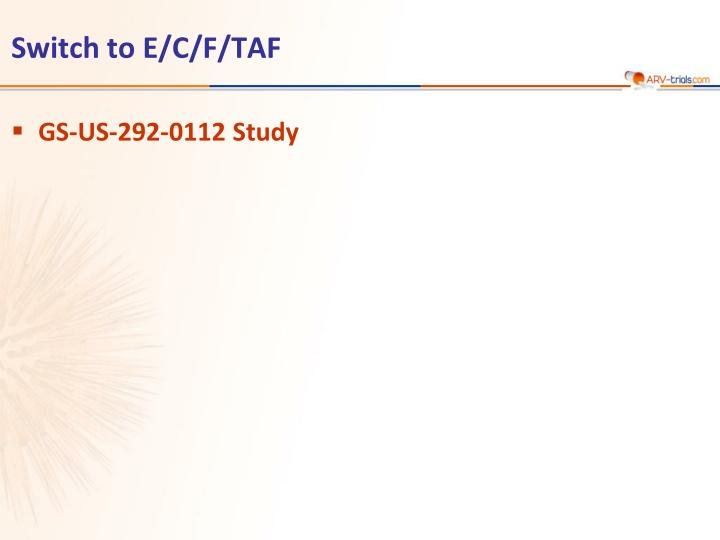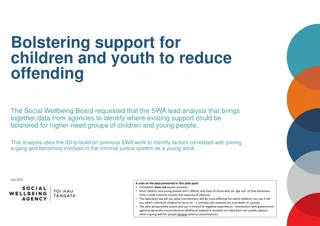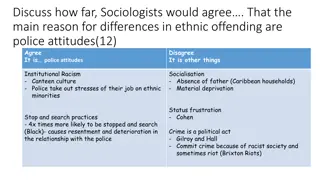The Role of Mental Health Treatment in Preventing Offending Behavior
The study investigates the association between psychosis and offending to understand the effectiveness of mental health treatment programs in reducing re-offending rates among individuals with mental disorders like schizophrenia and bipolar mood disorder. Psychosis is identified as a risk factor for criminal activities, with a significant impact on violent offending behaviors. By analyzing data from the NSW Court Diversion Programme and health services, the research aims to provide insights into preventing future criminal activities through early intervention and treatment.
Download Presentation

Please find below an Image/Link to download the presentation.
The content on the website is provided AS IS for your information and personal use only. It may not be sold, licensed, or shared on other websites without obtaining consent from the author.If you encounter any issues during the download, it is possible that the publisher has removed the file from their server.
You are allowed to download the files provided on this website for personal or commercial use, subject to the condition that they are used lawfully. All files are the property of their respective owners.
The content on the website is provided AS IS for your information and personal use only. It may not be sold, licensed, or shared on other websites without obtaining consent from the author.
E N D
Presentation Transcript
Switch to E/C/F/TAF GS-US-292-0112 Study
GS-US-292-0112 Study: Switch to E/C/F/TAF in patients with renal impairment Design Open-label W24 W96 HIV+ 18 years Undetectable HIV-1 RNA 6 months HIV-1 RNA < 50 c/mL at screening Estimated creatinine clearance (Cockroft-Gault) 30-69 mL/min, stable in past 3 months CD4 50/mm3 No resistance to EVG, TDF or FTC No HBV or HCV co-infection N = 242 Switch to E/C/F/TAF Co-formulated EVG 150 mg, COBI 150 mg, FTC 200 mg and TAF 10 mg (E/C/F/TAF) qd with food Endpoints Primary: change from baseline at W24 in estimated glomerular filtration rate by various formulas: Cockroft-Gault, CKD-EPI-cystatin C, CKD-EPI-creatinine Secondary: eGFR at W48 and W96, measured GFR, renal and bone biomarkers, hip and spine BMD (DXA), adverse events, virologic control Pozniak A. JAIDS 2016;71:530-7 GS-US-292-0112
GS-US-292-0112 Study: Switch to E/C/F/TAF in patients with renal impairment Baseline characteristics Baseline eGFR < 50 mL/min N = 80 59 26% 18% 98% 622 Baseline eGFR 50 mL/min N = 162 58 18% 19% 98% 635 Median age, years Female Race : black HIV-1 RNA < 50 c/mL CD4 cell count (/mm3), median eGFR, median Cockroft-Gault, mL/min CKD-EPI, creatinine, mL/min/1.73 m2 CKD-EPI, cystatin C, mL/min/1.73 m2 Dipstick proteinuria : grade 1 or 2 Urine protein:creatinine (UPCR) 200 mg/g Urine albumin:creatinine (UACR) 30 mg/g Pre-switch TDF use Hypertension Diabetes 43 45 57 44% 56% 64% 58% 50% 15% 60 58 77 27% 35% 42% 69% 34% 13% Pozniak A. JAIDS 2016;71:530-7 GS-US-292-0112
GS-US-292-0112 Study: Switch to E/C/F/TAF in patients with renal impairment Estimated GFR (mL/min): Median change from Baseline to Week 24 Total < 50 mL/min 50 mL/min 5 +3.8 +3.8 +3.8 +1.2 + 0.3 0 -0.4 - 0.9 -1.8 -2.2 eGFRCKD-EPI Cr mL/min/1.73m2 eGFRCG mL/min eGFRCKD-EPI cys C mL/min/1.73m2 -5 No clinically appreciable change in estimated creatinine clearance In 32 patients, GFR was measured by iohexol clearance: actual GFR was not affected over 24 weeks of treatment for the whole group, subgroups with baseline eGFRCG< 50 vs 50, or with or without TDF prior to switch Pozniak A. JAIDS 2016;71:530-7 GS-US-292-0112
GS-US-292-0112 Study: Switch to E/C/F/TAF in patients with renal impairment Proteinuria: median value (mg/g) at baseline and W48 Non-TDF Total* TDF* Baseline Week 48 3 477 1 563 200 1 600 1 525 189 161 160 1 200 109 120 801 800 105 80 85 78 399 41 400 40 29 228 18 197 221 214 207 151 166 14 10 10 0 0 -2-m:Cr RBP:Cr UPCR UACR Tubular Proteins *All Total and TDF changes statistically significant; all non-TDF changes not statistically significant. Pozniak A. JAIDS 2016;71:530-7 GS-US-292-0112
GS-US-292-0112 Study: Switch to E/C/F/TAF in patients with renal impairment Clinically significant proteinuria and albuminuria: baseline and W48 Proteinuria (UPCR) Albuminuria (UACR) 200 mg/g > 200 mg/g 30 mg/g > 30 mg/g 100 100 9 11 13 21 25 35 37 80 80 42 42 49 56 64 60 60 91 89 87 40 40 79 75 65 63 58 58 51 44 20 20 36 0 0 BL W48 BL W48 BL W48 BL W48 BL W48 BL W48 eGFR 50 mL/min eGFR < 50 mL/min eGFR < 50 mL/min eGFR 50 mL/min Total Total Pozniak A. JAIDS 2016;71:530-7 GS-US-292-0112
GS-US-292-0112 Study: Switch to E/C/F/TAF in patients with renal impairment BMD: mean change (%, SD) from baseline to W48 TDF Non-TDF Total Hip Spine 4 4 2.95* 2.29* 1.85* 1.47* 0.70 2 2 0.99 0 0 -2 -2 Baseline N = 236 W24 N = 226 W48 N = 214 Baseline N = 236 W24 N = 225 W48 N = 216 Hip Spine *p < 0.05 by two-sided Wilcoxon signed-rank test 6 % 4 % BMD change at week 48 > 3 % gain Gain or loss < 3 % > 3 % loss 37 % 37 % 59 % 72 % Pozniak A. JAIDS 2016;71:530-7 GS-US-292-0112
GS-US-292-0112 Study: Switch to E/C/F/TAF in patients with renal impairment Adverse events Most common adverse events Diarrhea 11% Upper respiratory tract infection 9% Arthralgia 9% Bronchitis 8% Osteopenia 8% Nausea 8% Headache 7% Pain in extremity 7% Back pain 7% Dizziness 6% Fatigue 6% Renal cyst 6% Cough 6% Adverse events leading to study drug discontinuation, N = 8 (3%), 2/8 for decreased GFR (both patients with hypertension) Fractures, N = 6, all related to mechanical trauma Pozniak A. JAIDS 2016;71:530-7 GS-US-292-0112
GS-US-292-0112 Study: Switch to E/C/F/TAF in patients with renal impairment Fasting lipid changes Decrease in patients who used non-TDF-containing regimens prior to switching to E/C/F/TAF Increase in those using TDF-containing regimens prior to E/C/F/TAF Pharmacokinetics EVG and COBI: in the range of historical data in patients without renal impairment FTC: higher than historical data in patients without renal impairment, higher in patients with eGFR < 50 mL/min vs 50 mL/min TAF: consistent with historical data in patients without renal impairment TFV: higher than historical data in patients without renal impairment, but well below the TFV exposures from TDF-containing regimens Efficacy at W48 HIV-1 RNA < 50 c/mL: 92% Virologic failure: 1% (N = 3) Pozniak A. JAIDS 2016;71:530-7 GS-US-292-0112
GS-US-292-0112 Study: Switch to E/C/F/TAF in patients with renal impairment Conclusion In virologically suppressed HIV-infected subjects with renal impairment, switch to E/C/F/TAF was associated with minimal change in eGFR Proteinuria and albuminuria significantly improved Bone mineral density significantly improved in patients receiving TDF-containing regimens prior to switching to E/C/F/TAF Virologic success was maintained in 92% of patients These data support the efficacy and safety of once daily E/C/F/TAF in HIV-1 infected patients with mild (eGFR 50-69 mL/min) or moderate (eGFR 30-49 mL/min) renal impairment without dose adjustment Pozniak A. JAIDS 2016;71:530-7 GS-US-292-0112























